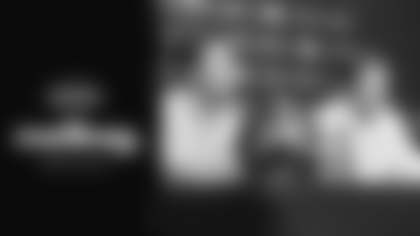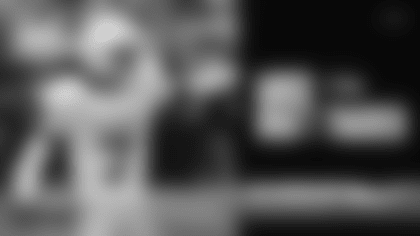When K.J. Wright made a leaping, one-handed interception in Seattle's Week 5 win over Minnesota, it was easy to wonder how Vikings quarterback Kirk Cousins could have missed seeing the Seahawks linebacker dropping into coverage.
In Cousins' defense, however, Wright wasn't supposed to be there.
"I shouldn't have been there, but I saw a guy clearly wide open, so I backed up a little bit," Wright said before adding with a laugh, "He tried my vertical on that play. He didn't think I could jump that high."
Had Wright, who was playing strongside linebacker on the play, just stuck to his assignment as the buzz defender, he would have been responsible for tight end Kyle Rudolph in the flat on the play-action pass. But Wright's football intelligence and instincts—and well as his considerable experience at weakside linebacker—caused Wright to recognize a potential coverage bust.
Vikings receiver Justin Jefferson was completely uncovered running an over route, and Wright recognized that, adjusted on the fly, and covered for an out-of-position teammate by making a highlight-reel play. If you watch the play in question, you can see Wright, all in an instant, recognize the problem, begin back peddling, all while still keeping an eye on Rudolph, before eventually getting into position to make a spectacular interception.
It was only one play in a 10-year career full of big stops, takeaways, tackles for loss and screen passes wrecked, but it was a perfect illustration of what has made Wright one of the NFL's best linebackers over the past decade, and of why he has so easily handled a move back to a position he hasn't played since 2013, and if we're being honest, a position that wouldn't be his first choice if it were up to him.
Wright began his career playing middle linebacker due to an injury to starter David Hawthorne, but then spent most of his rookie season and the next two years at strongside linebacker. Wright played very well there, but moved to weakside linebacker when the Seahawks transitioned Bruce Irvin from defensive end to the strongside spot. After spending most of his career at the weakside spot, Wright feels more comfortable there, but when Irvin went down with a knee injury in Week 2, and with Seattle's next best linebackers, Jordyn Brooks and Cody Barton, being better suited for the weakside role, Wright was asked to go back to his old spot.
Wright didn't exactly celebrate the move, but he understood it was best for the team, and he has thrived in that role, putting together three very strong performances in wins over Dallas, Miami and Minnesota.
"If you had any idea the fights and conversations we had about moving his position," defensive coordinator Ken Norton Jr. said with a laugh. "And now that he's playing so well, it's just a testament to his work ethic, his versatility, his ability to hit the books and make a commitment to being a team player. He's certainly stepped up and we're excited about it. He has been an example for everybody else… He was always very special and versatile from Day 1, and now in year 10, nothing has changed. He's been able to help us, he's been able to be that guy who can play at a high level anywhere you put him on the field."
Wright joked that 10 years of experience "didn't get me far, clearly," in those debates with coaches over his position, but it's not like he started sulking after switching roles. In three games since moving to the strongside spot, Wright has recorded 20 tackles, two tackles for loss, five passes defensed, an interception, a forced fumble and a fumble recovery.
"I've been doing the weakside for the past eight, nine years and been making a lot of plays there," he said. "I feel like I can be like a field general behind the ball and make all the checks and go sideline to sideline. When I'm at the Sam, it's just different—I'm buzzing a lot, taking on tackles a lot, tight ends a lot. So yeah, we definitely have some conversations about it. I've tried to get (Norton) to change it, it didn't happen. But in life, you've just got to make the most of whatever you're in, so I've been doing my very best at Sam, I've made a lot of plays there, so it's going good."
There are differences in the two positions, most notably where they line up, with the weakside linebacker normally off the line of scrimmage not far from middle linebacker Bobby Wagner, while the strongside linebacker is close to the line of scrimmage, often taking on tight ends and having to set the edge on running plays. But Wright's considerable knowledge of the entire defense means it hasn't been too big of an adjustment going back to his old spot, as his recent performances have shown.
And as Wright notes, it hasn't been a full-time position switch anyway. When the Seahawks have played their nickel defense with two linebackers on the field, Wright goes back to his old spot by Wagner, meaning he's only playing part of each game at strongside linebacker when the Seahawks are in their base defense. Traditionally, the weakside linebacker in the base defense would stay on the field with he strongside linebacker coming of in nickel, so Wright is essentially playing two positions in every game.
"In the grand scheme of things, it's going to be just fine," he said. "I trust whatever plan there is. And the good thing about this is that on nickel, I'm off the ball. Nickel, I'm at the Will, so I get the best of both worlds."
Wright's ability to embrace a position switch that wasn't his first choice, then play this well, is just the latest example of what has made him such a respected player by teammates and coaches over the past decade.
"He's been a great teammate about that and said, 'Well I'll do whatever you want me to do,'" Seahawks coach Pete Carroll said earlier this month. "And he's played really well, so we're excited about that."
Carroll added that Wright is "a perfect teammate, he really is a perfect teammate… And he's really not just survived it he's excelling in doing great. So it says everything about him I think, but he's been speaking and screaming loudly about who he is for years around here."















